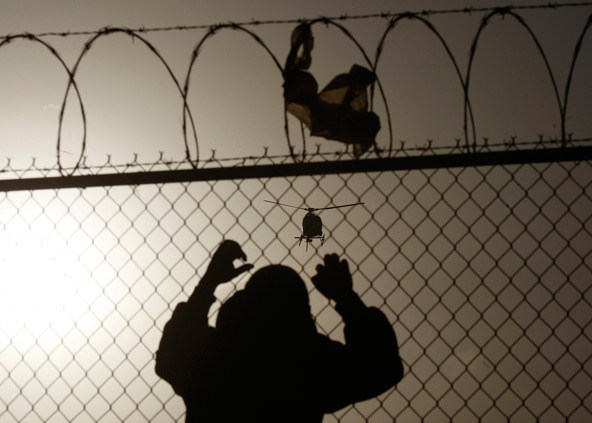
TUCSON, Ariz. (CNS) — Standing up with faith communities in support of migrants who cross the border illegally has long been an interreligious effort in southern Arizona.
During a five-day Social Action Summer Institute at the University of Arizona in June, Tucson Bishop Gerald F. Kicanas, Archbishop Jose Ulises Macias Salcedo of Hermosillo, Mexico, and current and former leaders of Protestant, Jewish and Episcopal congregations laid out what motivates their efforts and how their communities take on different aspects of aiding and advocating for immigrants.
Archbishop Macias in a homily at the opening Mass of the institute explained how the word “pontiff” or “pontifice” in Spanish has Latin roots in the term “bridge-builder.” He called upon the participants to become “pontiffs” between immigrants and the rest of society.
“We should not be building walls, but bridges,” he said. “But this is difficult work.”
“Here they would say, ‘Tell people not to come,’ while we in Mexico say, ‘There’s no work here,'” Archbishop Macias said. “Once people have a dream nothing can stop them. People will continue to come across.”
The faith groups of the border region have created “a wonderful bridge, connecting Sonora with Arizona,” he said. The states border each other in Mexico and the U.S., respectively. Shared efforts of the Catholic Church on either side of the border include humanitarian assistance to people who are crossing or who have been deported; education about the dangers of crossing and about why people try to cross; efforts to create sustainable employment in Mexico; and annual cross-border celebrations such as Las Posadas.
“Above all, we are one church” even across borders, said Archbishop Macias. “But we need more ‘pontiffs,'” to continue being bridges, he added.
The institute for parish, diocesan and church agency social-action workers focused on the role of religious people and institutions on the border. It coincided with congressional consideration of immigration reform legislation in Washington.
Speaking at various points during the institute, Bishop Kicanas described his own transition from Chicagoan to Tucsonan, learning not just to appreciate things like cactus but also the region’s mission heritage, begun by Jesuit Father Eusebio Francisco Kino, “who we hope someday will be canonized.”
Bishop Kicanas described Father Kino as an astronomer, cartographer and rancher as well as founder of more than two dozen Catholic missions across what is now northern Mexico, California, Arizona and New Mexico. The region was, even in Father Kino’s 18th century, a place of regular migration, he said.
At a panel with clergy of other faiths, Bishop Kicanas introduced as friends and collaborators Rabbi Thomas Louchheim of Congregation Or Chadash, the Rev. Alison Harrington, pastor of Southside Presbyterian Church, and the Rev. Stephen Springer, pastor of Dove of Peace Lutheran Church, all from Tucson; the Rev. Randy Mayer, pastor of Good Shepherd United Church of Christ in Sahuarita, Ariz.; and West Cosgrove, director of education at the Kino Border Initiative, a Jesuit education and migrant support organization based in Nogales, Ariz.
The clergy each discussed the challenges of bringing the teachings of their faith to congregations that sometimes are less than charitable toward immigrants many consider only as lawbreakers.
Rev. Mayer said he thinks of his own town close to the Mexican border as a lot like Babylon. “It’s very conservative and sometimes seems godforsaken.”
But despite having a barracks of the Border Patrol in Sahuarita, and many local residents with strong sympathies for the law enforcement side of the immigration debate, Rev. Mayer said 200 people from his congregation are involved in immigrant ministry. Some join searches in the desert for people who are in trouble, some volunteer in dining rooms that feed migrants, others engage in advocacy. That includes going door-to-door talking to people about immigration and responding to news stories about immigrants; writing letters to the editor to counter negative portrayals and correct mistakes.
Rev. Springer said the evangelical Lutherans are recognizing that they have “a duty to speak up” on behalf of migrants in part by their growing presence with in the church. This became apparent last year when the synod held an assembly in Las Vegas. With Arizona having implemented a tough immigration enforcement law, known as S.B. 1070, some predominantly Spanish-speaking congregations in Phoenix “were afraid to travel,” worried that they might be stopped and asked for proof of immigration status on the hours-long drive across the state.
“It has forced us to get out of our comfort zone and speak to each other,” he said.
Rabbi Louchheim said Jewish history, back to Moses leading the people through the desert for 40 years, gives Jews a kinship with contemporary migrants. He noted that the previous week’s reading from the Torah told the story of Moses asking permission to bring the people through a particular land. The king refused. “They had to go around,” the rabbi said. “And that’s how we have to do this.”
One way of “going around” is to break the problem of the immigration system into manageable bites, he said. For instance, focusing on the risks people take to improve their families’ situations.
“People shouldn’t die from dehydration,” said Rabbi Louchheim, explaining that such a message provides a starting point for a conversation about immigration.
Concluding the session, Bishop Kicanas said there’s a lesson in the example of the religious leaders, who quite obviously were well acquainted and comfortable with each other.
“Maybe the biggest message here is we need to form alliances,” he said. “The issues are so potent, so complex that unless we form alliances we won’t have much of an impact.”
— By Patricia Zapor Catholic News Service






